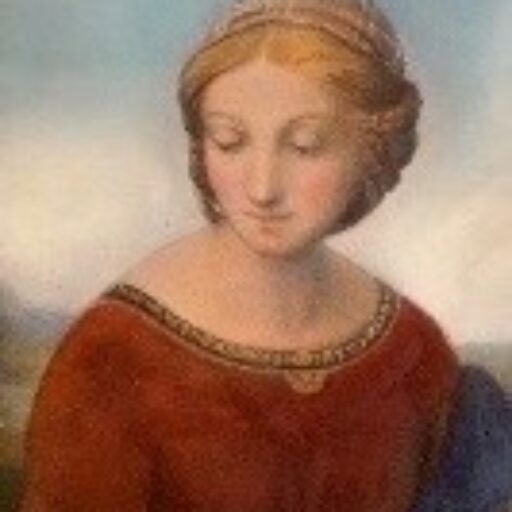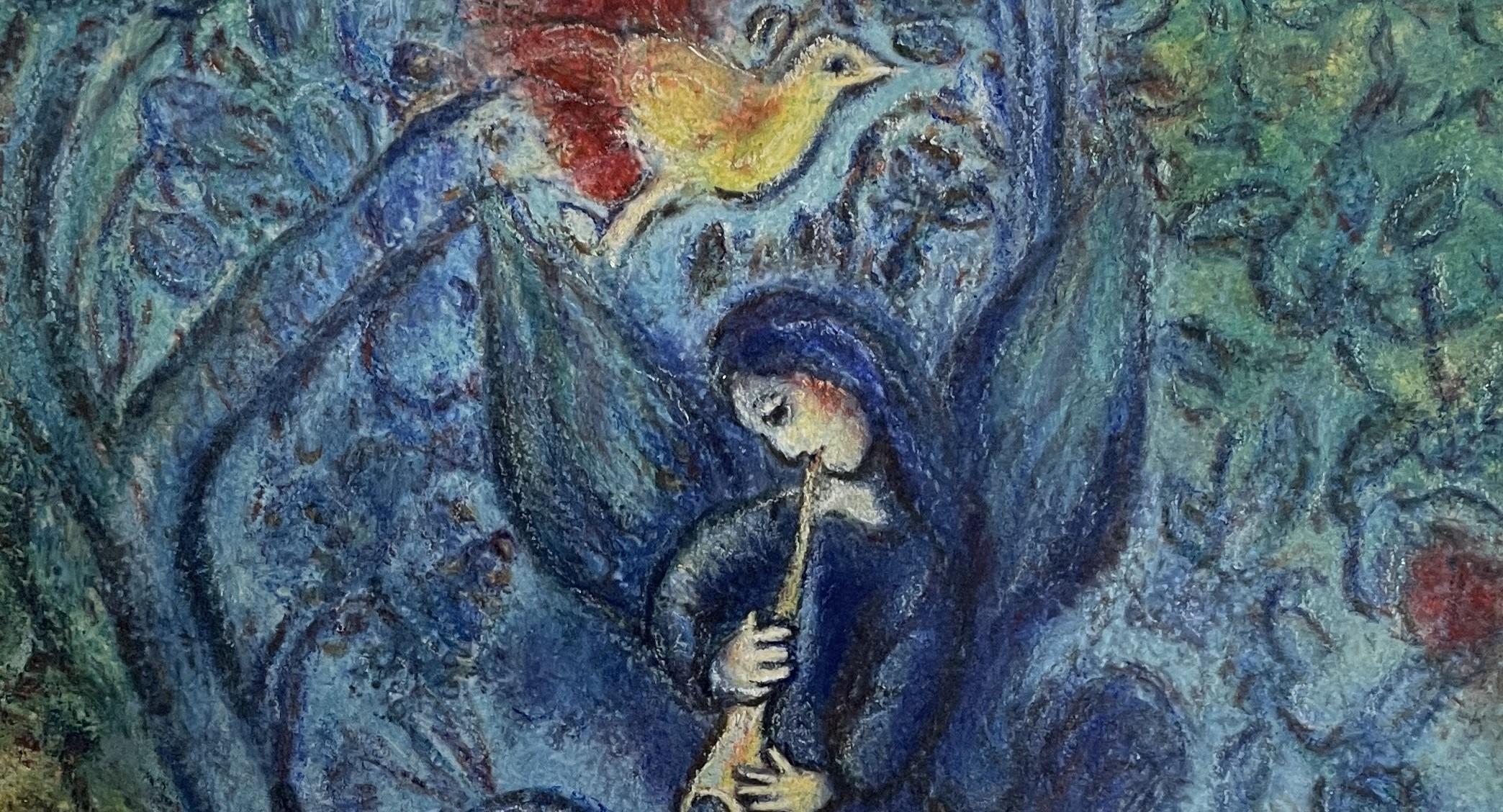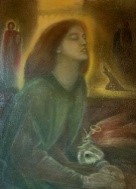日本語-Englishー台灣華語
ダンテ・ゲイブリエル・ロセッティ「ベアタ・ベアトリクス」
ボッティチェリを再発見したラファエル前派は、ラファエル以前の素朴で敬虔な精神に溢れた芸術に立ち帰り、新しい表現を生み出そうとした英国の芸術活動である。ラファエル前派は当初執拗なまでの自然描写を追求し、独特の雰囲気を醸し出す絵画を生み出して行ったが、文学や神話に傾倒する題材は次第に耽美主義的な傾向を強めて行き、思いのほか早期に個々の画家の個性に帰着してしまう。
中世のフレスコ画を思わせる鮮やかな色彩のラファエル前派の中でも、私はとりわけロセッティが好きだ。ロセッティはラファエル前派の設立宣言の中で「因習的なものに囚われることなく、自然を注意深く観察し、真摯な気持ちで本当にすぐれた絵画を制作することこそ、我々の本旨である」と述べているが、現実のロセッティは次第にこれとはまるで正反対の生活を送るようになる。ロセッティの絵には愛の情念が色彩となってうねっている。ロセッティは同じ構図の絵を何度も描いているが、その出来不出来は大きく揺れ動く。金銭の不足が画家の情緒不安的を激しく増幅させるのか、愛の振幅がそうさせるのか。ロゼッティは画家とモデル以上の関係を結ばなければ描くことができなかった。画家としての欲望を満たすために、恋人と娼婦と愛人の三人の女性を必要としていた。メランコリックで神秘的な女性エリザベス・シダル。シダルとは正反対の性的で肉感的な女性ファニー・コンフォース。愛と官能の女性ジェイン・バーデン。どの女性をモデルとした絵であるかはよく観ると区別がつくのだが、実際に描いてみるといずれでもありえるような錯覚に陥る時がある。ロセッティは異なる三人格を絵の中で統合していたのかもしれない。ただ最後の瞬間にだれかの外形を残していたに過ぎないように思えてくる。ロセッティの絵は、情緒不安定で破滅型の人間が描いたとは思えない程、きっちりと彩色されているが、最晩年には借金と麻薬中毒に苦しみながら、ベアトリーチェのもとに召されて行く。
ベアタ・ベアトリクス(至福のベアトリーチェ)はロセッティの最高傑作であることは間違いないが、複数のバージョンがありその差は大きい。この絵はテートギャラリーにあるベアタ・ベアトリクスである。ベアトリーチェは詩人ダンテが生涯愛した女性である。夢見るような眼差しと透けるような肌を持った神秘的なシダルは、ロセッティにとってはベアトリーチェの霊感の泉だった。ベアトリーチェが地上から天国に召されていく姿を描いた「ベアタ・ベアトリクス」は、シダルをモデルに描かれた。愛と死の使者である赤い鳩が、阿片の原料となる芥子の花を運んで来る。日時計はベアトリーチェの死の時刻九時を指している。愛の天使が最後の命の炎を燃やしている。黄金の光輝く中、永遠の恋人ベアトリーチェの魂は恍惚となって天に召されて行く。その消え行く炎を不安な眼差しで見詰める詩人ダンテの姿は、ダンテ・ゲイブリエル・ロセッティその人である。罪悪感と後悔に打ちのめされながらも、ロセッティはまるでベアトリーチェを自ら生み出すかのようにシダルを追い詰め、シダルの死をベアトリーチェの最期の姿に重ね合わせる。
詩人だった父親からダンテという名を授けられた画家は、ダンテの詩に心酔し、この世に存在しない運命の女を生涯追い求め続けたのかもしれない。詩人の死から五百年の後に、妻の死という計り知れない犠牲を払って、ベアトリーチェはロセッティによって絵画の中に封印されたのである。この絵の中のシダルは歓びに満ちている。私は描きながら、シダルがロセッティの呪縛から逃れ、安らかな眠りにつけることを祝福するとともに、ロセッティがシダルへの悔恨の情を抱きながらこの絵を何度も描いたであろうことを強く感じるのだった。
Beata Beatrix
The Pre-Raphaelite Brotherhood, who rediscovered Botticelli, was a British art movement that aimed to return to the art filled with the naive and devout spirit before Raphael, seeking to create new expressions. Initially, the Pre-Raphaelites pursued obsessive natural depiction, producing paintings with a unique atmosphere. However, their themes, deeply immersed in literature and mythology, gradually adopted a more aesthetic tendency, and surprisingly quickly reverted to the individual personalities of the artists.
Among the Pre-Raphaelites, known for their vivid colors reminiscent of medieval frescoes, I particularly like Rossetti. In the founding manifesto of the Pre-Raphaelite Brotherhood, Rossetti stated, “Our main purpose is to produce genuinely excellent paintings with a sincere heart, carefully observing nature without being ensnared by conventionalities.” However Rossetti gradually led a life quite contrary to this. His paintings pulse with the passion of love. Despite repeatedly painting the same compositions, the quality of his work fluctuated significantly. It’s unclear whether the lack of money intensely amplified the painter’s emotional instability or if it was the amplitude of love. Rossetti could not paint unless he formed a relationship beyond that of an artist and model. He needed three women to satisfy his desires as a painter: a lover, a prostitute, and a mistress. The melancholic and mystical Elizabeth Siddal, the sexually and sensually Fanny Cornforth, and Jane Burden, a woman of love and sensuality. While it’s possible to distinguish which woman modeled for which painting upon close inspection, sometimes one might fall into the illusion that it could be any of them. Rossetti might have integrated these three different personalities into his paintings, leaving only someone’s figure at the last moment. Despite Rossetti’s paintings being neatly colored, not suggesting they were made by a person unstable and doomed, in his final years, he suffered from debt and drug addiction, moving towards Beatrice.
“Beata Beatrix” (Blessed Beatrice) is undoubtedly Rossetti’s masterpiece, although there are several versions with significant differences. This painting is the Beata Beatrix at the Tate Gallery. Beatrice was the woman whom the poet Dante loved all his life. The mystical Siddal, with her dreamy gaze and translucent skin, was Rossetti’s muse for Beatrice. “Beata Beatrix,” depicting Beatrice being called from Earth to heaven, was modeled after Siddal. A red dove, the messenger of love and death, brings a poppy, the source of opium. The sundial points to the hour of Beatrice’s death at nine. An angel of love burns the last flame of life. In the golden glow, the soul of the eternal lover Beatrice ecstatically ascends to heaven. The figure of the poet Dante, staring anxiously at the fading flame, is Dante Gabriel Rossetti himself. Overwhelmed by guilt and regret, Rossetti, as if creating Beatrice himself, relentlessly pursued Siddal, overlaying Siddal’s death with Beatrice’s final moment. The painter, named Dante by his poet father, might have been infatuated with Dante’s poetry, chasing a woman of fate that did not exist in this world. Five hundred years after the poet’s death, Beatrice was sealed in a painting by Rossetti at the immeasurable cost of his wife’s death. Siddal in this painting is filled with joy. While painting, I strongly feel that Siddal was blessed to escape Rossetti’s curse to a peaceful rest, and Rossetti, filled with remorse towards Siddal, must have painted this scene multiple times.
丹特·加百列·羅賽蒂《至福的貝亞特麗斯》
發現波提切利的前拉斐爾派是一場英國藝術運動,該運動試圖回歸拉斐爾之前那種樸素而虔誠的藝術精神,並創造新的表達方式。前拉斐爾派最初堅持對自然的執著描繪,創造出獨特的氛圍,但漸漸地,他們對文學和神話的偏愛開始顯示出趨於唯美主義的傾向,並意外地迅速演變成反映個別畫家特色的藝術。
在所有前拉斐爾派那些鮮豔色彩、讓人聯想到中世紀壁畫的作品中,我特別喜歡羅賽蒂。羅賽蒂在前拉斐爾派的創立宣言中提到,“不受傳統束縛,仔細觀察自然,以誠摯的心創作真正優秀的畫作,是我們的宗旨。”但實際上,羅賽蒂的生活逐漸走向了完全相反的方向。羅賽蒂的畫中,愛的情感化作色彩波動。羅賽蒂多次繪製同一構圖的畫作,其成敗大不相同。是缺乏金錢使得畫家的情緒不穩定加劇,還是愛的波動造成的呢?羅賽蒂似乎只有與畫中人物建立超越畫家和模特的關係後才能描繪出來。為了滿足作為畫家的欲望,他需要三個女性:情人、妓女和愛人。既憂鬱又神秘的女性伊麗莎白·希達爾,與希達爾截然不同,性感而肉感的女性范妮·康佛思,還有充滿愛與感官的女性珍·莫里斯。細看便能區分出哪些畫作是以哪位女性為模特,但實際上畫起來時,有時會陷入似乎任何一位都可能是模特的錯覺。羅賽蒂可能在畫中整合了三種不同的人格。但在最後一刻,似乎只留下了某人的外形。羅賽蒂的畫作雖然是由一個情緒不穩定、傾向於自我毀滅的人所繪製,但色彩卻異常精確,晚年時他在債務和毒癮的折磨下,彷彿被召喚至貝亞特麗斯身邊。
《至福的貝亞特麗斯》無疑是羅賽蒂的杰作,儘管存在多個版本,這些版本之間的差異很大。這幅畫是藏於泰特美術館的《至福的貝亞特麗斯》。貝亞特麗斯是詩人但丁一生所愛的女性。夢幻般的目光和透明的肌膚使得神秘的希達爾成為羅賽蒂眼中貝亞特麗斯靈感的源泉。《至福的貝亞特麗斯》描繪了貝亞特麗斯從人間升天的場景,以希達爾為模特。愛與死的使者,一隻紅鴿帶來了用於製作鴉片的罌粟花。日晷指向了貝亞特麗斯去世的時間——九點。愛的天使在最後一刻點燃生命之火。在金色的光芒中,永遠的戀人貝亞特麗斯的靈魂被恍惚地召喚至天堂。詩人但丁(丹特·加百列·羅賽蒂本人)以不安的眼神凝視著逝去的火焰。儘管深感罪惡和後悔,羅賽蒂仿佛將希達爾逼入絕境,將她的死與貝亞特麗斯的最後形象重疊。被賦予但丁這個名字的畫家,可能是迷戀著父親是詩人的事實,終其一生追求那個在這世上不存在的命運女性。在妻子死後五百年,經過難以估量的犧牲,貝亞特麗斯被羅賽蒂封印在畫中。畫中的希達爾充滿了喜悅。我在繪畫時強烈感受到,希達爾從羅賽蒂的束縛中解脫,進入安詳的睡眠,同時羅賽蒂在繪製這幅畫時也必定充滿了對希達爾的悔恨之情。


